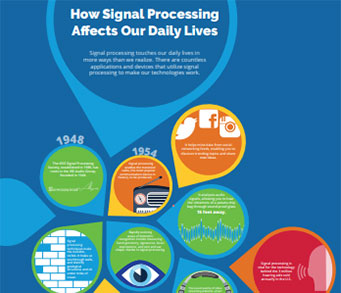SPS Feed
Top Reasons to Join SPS Today!
1. IEEE Signal Processing Magazine
2. Signal Processing Digital Library*
3. Inside Signal Processing Newsletter
4. SPS Resource Center
5. Career advancement & recognition
6. Discounts on conferences and publications
7. Professional networking
8. Communities for students, young professionals, and women
9. Volunteer opportunities
10. Coming soon! PDH/CEU credits
Click here to learn more.
The Latest News, Articles, and Events in Signal Processing
This paper proposes a Model-Based Online Learning (MBOL) framework for waveform optimization in integrated sensing and communications (ISAC) systems. In particular, the MBOL framework is proposed to enhance the ISAC performance under dynamic environmental conditions. Unlike Model-Free Online Learning (MFOL) methods, our approach leverages a rich structural knowledge of sensing, communications, and radio environments, offering better explainability and sample efficiency.
Signal processing techniques have played a pivotal role in the early development of joint sensing and communication systems [1]. These efforts were driven by the need to address spectrum scarcity and to reduce hardware size and cost. Initially focused on dual-function radar-communication systems, this field has since evolved into the broader paradigm of Integrated Sensing and Communication (ISAC).
We introduce ICE-TIDE, a method for cryogenic electron tomography (cryo-ET) that simultaneously aligns observations and reconstructs a high-resolution volume. The alignment of tilt series in cryo-ET is a major problem limiting the resolution of reconstructions. ICE-TIDE relies on an efficient coordinate-based implicit neural representation of the volume which enables it to directly parameterize deformations and align the projections.
Magnetic Resonance Imaging (MRI) is a widely used imaging technique, however it has the limitation of long scanning time. Though previous model-based and learning-based MRI reconstruction methods have shown promising performance, most of them have not fully utilized the edge prior of MR images, and there is still much room for improvement.
While snapshot hyperspectral cameras are cheaper and faster than imagers based on pushbroom or whiskbroom spatial scanning, the output imagery from a snapshot camera typically has different spectral bands mapped to different spatial locations in a mosaic pattern, requiring a demosaicing process to be applied to generate the desired hyperspectral image with full spatial and spectral resolution.
Date: 22 January 2025
Time: 10:00 AM ET (New York time)
Presenter(s): Yanning Shen
Date: 1-4 November 2025
Location: Hong Kong
Date: 12-15 October 2025
Location: Lake Tahoe, CA, USA
We consider the problem of recovering off-the-grid spikes from linear measurements in the context of Single Molecule Localization Microscopy (SMLM). State of the art model-based methods such as Over-Parametrized Continuous Orthogonal Matching Pursuit (OP-COMP) with Projected Gradient Descent (PGD) have been shown to successfully recover those signals.
Single-satellite geolocation achieves effective localization of ground electromagnetic interference (EMI) signals with a low cost compared to the multi-satellite counterparts. In such systems, the Doppler and Doppler rate are commonly exploited to extract the information of the ground EMI sources and the constrained Unscented Kalman filter (cUKF) is found effective to provide instantaneous EMI locations over time.
Scene-Text Visual Question Answering (STVQA) is a comprehensive task that requires reading and understanding the text in images to answer the question. Existing methods of exploring the vision-language relationships between questions, images, and scene text have achieved impressive results. However, these studies heavily rely on auxiliary modules, such as external OCR systems and object detection networks, making the question-answering process cumbersome and highly dependent.
Blind image quality assessment (BIQA) is crucial for user satisfaction and the performance of various image processing applications. Most BIQA methods directly use the pre-trained model to extract features and then perform feature fusion. However, the features extracted by pre-trained models may contain irrelevant information to BIQA. Although some methodspre-train the feature extraction network from scratch, these approaches raise computational costs and resource demands.
Date: 6 May 2025
Time: 11:00 AM ET (New York Time)
Presenter(s): Dr. Quentin Bammey
Date: 12 March 2025
Time: 9:00 AM ET (New York Time)
Presenter(s): Dr. Ming Ding
Pages
SPS Social Media
- IEEE SPS Facebook Page https://www.facebook.com/ieeeSPS
- IEEE SPS X Page https://x.com/IEEEsps
- IEEE SPS Instagram Page https://www.instagram.com/ieeesps/?hl=en
- IEEE SPS LinkedIn Page https://www.linkedin.com/company/ieeesps/
- IEEE SPS YouTube Channel https://www.youtube.com/ieeeSPS
















